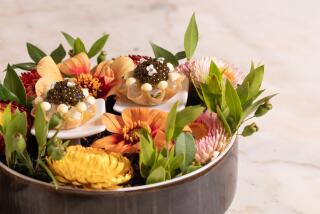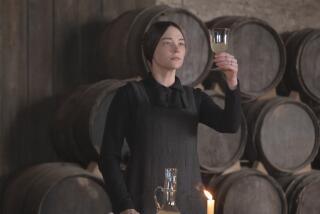Lafon: A Tale of Terroir
CARMEL â Sipping wine and chatting at a long table in a redwood-paneled private room at the tony Highlands Inn, Dominique Lafon doesnât look like a rebel.
Of course not many people would if they were sitting next to Jim Clendenen, the long-haired wine star from California who looks more like an escapee from the Oak Ridge Boys than one of Americaâs premier winemakers.
On the other hand, Lafon doesnât look much like a count, either. Though his square-cut features seem more appropriate to a French farmer, Lafon is the scion of Domaine des Comtes Lafon, one of the great wine houses in Burgundy.
The family name is synonymous with white wine, particularly Meursault. The family home is one of the most admired buildings in the region. Lafonâs great-grandfather is the founder of the famous La Paulee, the ritualistic feast in celebration of all things Burgundian that for more than 75 years has marked the finish of the Hospices de Beaune charity wine auction.
âYou canât really appreciate what this guy has done unless you think about the way it could have been,â Clendenen says. Lafon looks down, a little embarrassed.
âThis guy,â Clendenen continues without a pause, âwas born with parts of Le Montrachet and four premier cru vineyards in Meursault. How many people who were handed that kind of start would have had the courage to change? To take risks? Itâs awesome what heâs done.â
Itâs odd, really. Clendenen made his reputation by helping to carve a quality wine region from the untamed frontier that was Central California. Yet here he is extolling the virtues of a guy who would seem to represent the very same staid French tradition he and his confreres were rebelling against.
Thatâs because the house of Lafon is much more than appearances might indicate. Beneath its respectable, conservative surface lie tales of intrigue, family discord and--perhaps most surprising--almost constant revolution for the last 20 years.
The story begins with Jules Lafon, who built the family fortune around the turn of the century, amassing through purchase and marriage some of the best holdings in Burgundy. Unfortunately, when Jules died in the early 1940s, everything went to his son, Henri, who seems to have been the picture of the postwar playboy, running through much of the family wealth.
When Henriâs spendthrift habits finally threatened to force the sale of the home and vineyards, it was Dominique Lafonâs father, Rene, a cousin of Henri, who intervened. Against the familyâs wishes and against all odds, Rene, a Parisian engineer, actually managed to begin to turn the estate around.
One of the keys to his success was the decision to make his own wines. At that point in Burgundy, landholders usually paid workers to sharecrop the vineyards and make the wine, then both parties sold it to negociants, who bottled it under their own labels and sold it.
Though the Lafons still needed to have others work the land (they were, after all, absentee landlords), by making and selling their own wine, they were eventually able to generate enough capital to maintain and even improve the property.
Domaine des Comtes Lafon became one of the best-known wines of Meursault, famous for its honeyed texture, bracing acidity and massive, oaky muscularity. It was a wine for the ages, requiring at least a decade to approach drinkability.
In the mid-â80s, Dominique Lafon began to get involved. After attending wine school in Beaune, he gradually came to have more and more say in the way the domaine was run. For all intents and purposes, he took over the domaineâs operations in 1985.
Though most kids inheriting holdings like this--the vinous equivalent of large blocks of stock in both Microsoft and Netscape--would have been happy to sit tight and change nothing, Lafon had a different calling.
âThe first wines I made, I copied my father,â he says, midway through a retrospective of some of his best wines at the 1999 Masters of Food and Wine here at the Highlands Inn early this spring. âBut when you copy something, itâs never as good as the original.â
Gradually, Lafon began to craft wines in his own style. His goal was a wine that was more natural, in terms of both vineyard and cellar practices.
âI figured out that the vineyard and the cellar are going together,â he says. He joined the Burgundian movement toward organic vineyard management. In fact, Comtes Lafon was certified completely organic in 1998.
âThere is more life in the soil, and that shows in the wines. We are getting closer to what terroir should be, showing the contact between the vines and the earth.â
At the same time, his winemaking has simplified.
âThe more work you do in the vineyard, the less you need to do in the cellar,â he says. âThe first wines I made were not very much made in the vineyard, but I did a lot of smart--or not so smart--things in the cellar. Thereâs been much less work in the cellar on the later wines.
âYou want to be very discreet about winemaking. Too much of anything, and you lose that focused character or you hide it beneath the technique.
âThe wines Iâm most proud of now are more elegant than they were in the past,â Lafon says. âThey might not be as big, but theyâre more refined. I like that better. When a wine is delicate, you can drink a lot of it. When it is too heavy, you donât want to. And wine is meant to be drunk, not entered in contests.â
Those changes are evident when tasting through recent vintages of the Lafon Meursault âClos de Barreâ (far from the best vineyard, but it is, after all, the estateâs backyard). As the years progress, there is an increased sense of a kind of elegant simplicity to the wines. This is not to say that they are not complex, it is just that they are more focused, in a way that emphasizes a direct, well-attenuated style.
The â96, which Lafon says is his best wine yet, is still extremely acidic and tart, but beneath that are butter and mushrooms and mostly a characteristic taste almost like wet stones.
âThis is what I like,â Lafon says. âThis is still a little raw, but there is crystalline pure fruit, vibrant fruit.â
You get an idea of what the wine will turn into when you taste the â95. Though it came from an extremely small crop and is still intense and tightly wound, the extra year of age has turned the wine more generous and open.
It is in the â92 that the hallmark hazelnut-and-cream character of great Meursault really begins to show, and even more so in the â90, a good, big vintage that is minerally with a taste almost of shellfish stock.
The â89 is more honey than stone. Its texture is remarkable, softer and creamier with a rich, mouth-coating texture and a long finish. The â88 rounds out the remarkable string, leaner and more lemony with an almost herbal complexity.
The most interesting comparison, though, is with the 1985, Lafonâs first full year at the helm and a vintage for which the grapes were still raised under the control of others. Though it is a pleasant wine--particularly for a Chardonnay of that age--it pales beside the rest--especially given the general quality of the vintage. It is neither as creamy nor as complex, and actually seems like a completely different wine.
âEvery time I have a bottle of the â85 I have regrets,â Lafon says. âThat was such a great year, and I know that this wine is only 30% or 50% of what it could have been. Thereâs just too much winemaking.â
More to Read
Sign up for The Wild
Weâll help you find the best places to hike, bike and run, as well as the perfect silent spots for meditation and yoga.
You may occasionally receive promotional content from the Los Angeles Times.







